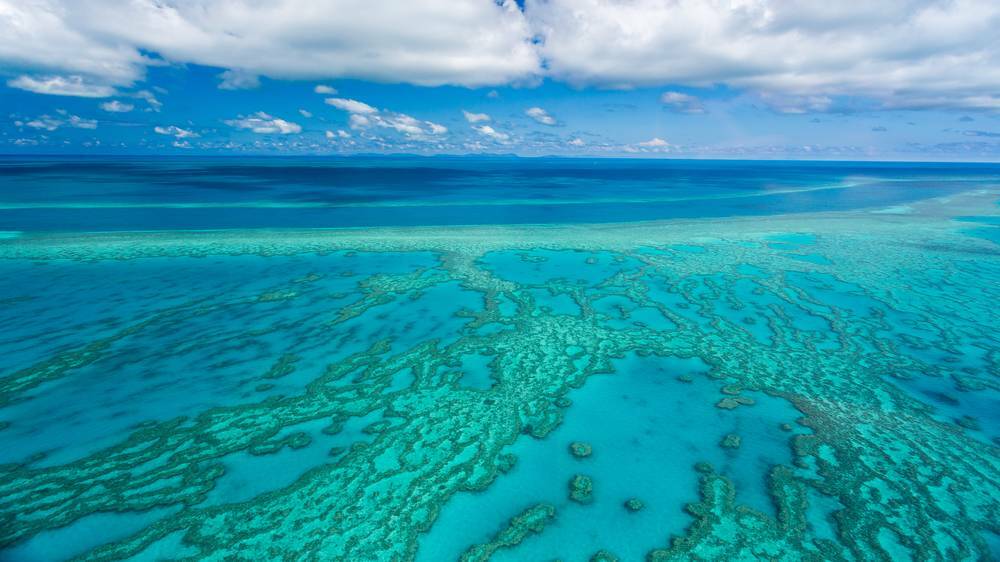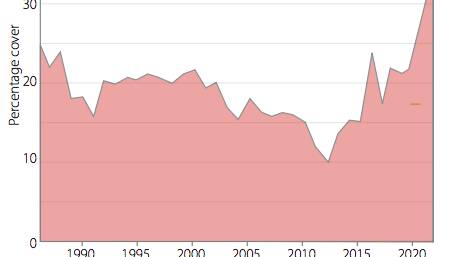
There has been a mixed reaction from scientists and researchers to the news that coral cover has increased across the much of the Great Barrier Reef for the second year in a row.
Published in early August, the Australian Institute of Marine Science's annual summary report on coral reef condition for 2021/22 shows that the northern and central sections of the Great Barrier Reef have recorded their highest amount of coral cover since it began monitoring 36 years ago.
In the 87 representative reefs surveyed between August 2021 and May 2022 under the AIMS Long-Term Monitoring Program, average hard coral cover in the region north of Cooktown increased to 36 per cent, from 27pc in 2021, and to 33pc in the central Great Barrier Reef, from 26pc in 2021.
However, average coral cover in the southern region from Proserpine to Gladstone decreased from 38pc in 2021 to 34pc.
According to AIMS CEO Paul Hardisty, the results in the north and central regions were a sign the reef could still recover, but the loss of coral cover in the southern region showed how dynamic it was.
"A third of the gain in coral cover we recorded in the south in 2020/21 was lost last year due to ongoing crown-of-thorns starfish outbreaks," he said. "This shows how vulnerable the reef is to the continued acute and severe disturbances that are occurring more often, and are longer-lasting."

Professor Peter Ridd, the former head of the Marine Geophysical Laboratory at James Cook University in Townsville who was fired in 2018 for pointing out quality assurance deficiencies in reef-science institutions, has welcomed the news.
In 2020 he was appointed to the Global Warming Policy Foundation as an advisor, and speaking on their behalf last week, said that in recent years, media outlets around the world had been reporting coral bleaching events in increasingly apocalyptic terms.
"This data proves that they are simply scaremongering," he said.
He recently produced a note, The Good News on Coral Reefs, for the GWPF.
GWPF director Dr Benny Peiser said the report was "just the latest example of empirical data making a mockery of the catastrophists", saying the data showed clearly how a handful of coral bleaching events that have affected the reef since 2016 have had very limited impact on overall coral cover.
"For how much longer do they think they can get away with it," he asked.
Fellow researcher Dr Jennifer Marohasy is less inclined to praise the findings, saying the report's claim of less than 30pc coral cover at about half the reefs surveyed is an "absurdly low percentage".
"The low percentage coral cover is because only the reef perimeter is surveyed by AIMS for those reports, which is the equivalent of reporting on the population of Sydney after skirting around the outer suburbs," she said. "Such a method would give no indication of population trends in more densely populated inner-city areas."
Dr Marohasy added that despite advances in both underwater and aerial drone mapping, which could provide automated quantitative assessments by habitat with a photographic and/or visual records, AIMS persisted with a method that involves towing an observer who guestimates coral cover.
"Their method is subjective and archaic," she said.
She linked the AIMS report's release with the passing of net zero legislation in the lower house of the federal parliament on the same day, saying that in March, AIMS was claiming more than 90pc of the reef was severely bleached.
"Now in August, just a few months later, the same organisation is claiming healthy corals and record high coral cover across more than two-thirds of the GBR," she said. "These two results are irreconcilable."
The bottom line, Dr Marohasy said, was that the survey was intended to help make the May federal election all about climate change.
AIM's Dr Hardisty said the increased frequency of mass coral bleaching events was "uncharted territory" for the reef, with this year's bleaching event the fourth in seven years and the first to occur during a La Nina.
"In our 36 years of monitoring the condition of the Great Barrier Reef we have not seen bleaching events so close together," he said.
"Every summer the reef is at risk of temperature stress, bleaching and potentially mortality and our understanding of how the ecosystem responds to that is still developing.
"The 2020 and 2022 bleaching events, while extensive, didn't reach the intensity of the 2016 and 2017 events and, as a result, we have seen less mortality. These latest results demonstrate the reef can still recover in periods free of intense disturbances."
AIMS monitoring program team leader Dr Mike Emslie said the 2022 results built on the increases in coral cover reported for 2021, with most of the increase continuing to be driven by fast-growing Acropora corals.
"These corals are particularly vulnerable to wave damage, like that generated by strong winds and tropical cyclones," he said.
ALSO MAKING NEWS:


